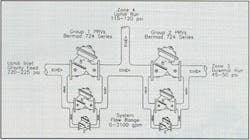For example, the topography in the immediate vicinity of an Avalon residential housing development in Fremont required a unique pressure reducing valving and control arrangement. Essentially, the 250-psig, high-pressure municipal water supply flowing through a 16-in. main line from a 3 million gal reservoir at an elevation of 580 ft had to be drastically reduced to supply two widely different water pressures in two laterals (Zones 3 and 4) within the development.
In addition, system flow requirements from near zero had to flow up to 3,100 gpm. The two zones required differing pressures:
45 to 50 psig service-water pressure was required by end use in lateral Zone 3 at an elevation approximately 300 ft below the pressure-reducing station.
In order to meet these dual-pressure system needs with fluctuating flow, a system with two sets of valves was required. Each set needed two pilot-operated valves and one small direct acting regulator (sizes: 8 in., 6 in. and 2 in., respectively). The intermediate-pressure (115 to 120 psig) Zone 4 lateral was installed between each of the two sets of valves.
Problem
Immediately after system startup, the pilot-operated valves installed in series experienced an unacceptable interaction resulting in uncontrollable hunting and pressure-control instability. This phenomenon was not totally unexpected by the water district. Their experience had shown that pilot-operated diaphragm valves installed in series tend to be inter-reactive (i.e., each responding to the actions of the other, back and forth). Because the system was already installed, the possible solutions were limited.
After determining the 6-in. and 8-in. valves could not be set to produce system stability, each main valve was converted from a single-chamber (one control chamber) to a double-chamber (two control chambers) valve. The existing pilot-loop configuration was then removed and replaced with a specially designed balanced pressure-reducing loop configuration which eliminated the uncontrollable hunting and pressure-control instability across the entire flow range designed for the system.
It was fortunate that the 6-in. and 8-in. valves originally purchased included a separation partition that made conversion from a standard single-chambered valve to a double-chambered design easy. If these valves had been typical single-chambered control valves, a high conversion cost would have been incurred, and complex modifications would have been required. The valves would also have to have been removed from the vault for complete reconstruction. As it was, the built-in flexibility of the Bermad standard, double-chambered, pressure-reducing control valves required only internal body plug/vent reversal to fully use both upper and lower chamber pressures as independent elements in the revised control scheme required for this installation.
In each state of pressure reduction, the three valves in parallel (8-in., 6-in. and 2-in.) provide the wide flow-range required. To ensure smooth flow transition from valve to valve as flow increases or decreases, a 5-psig set pressure differential exists between each valve activation pressure.


